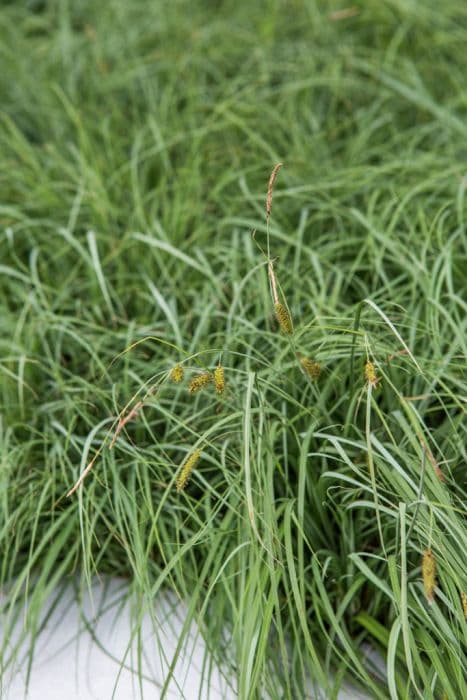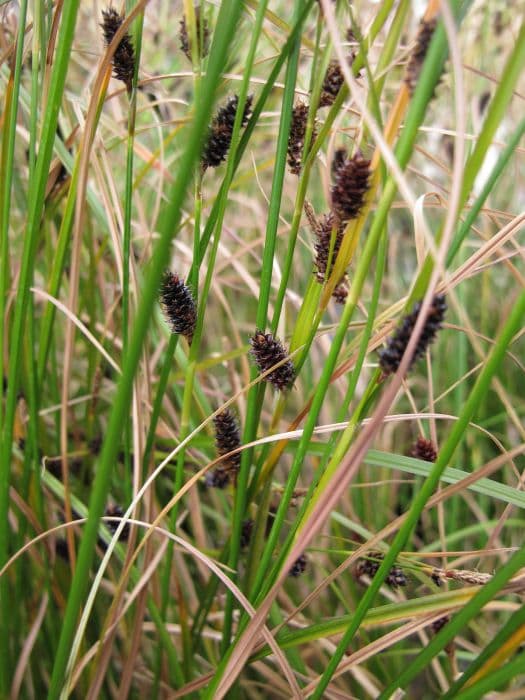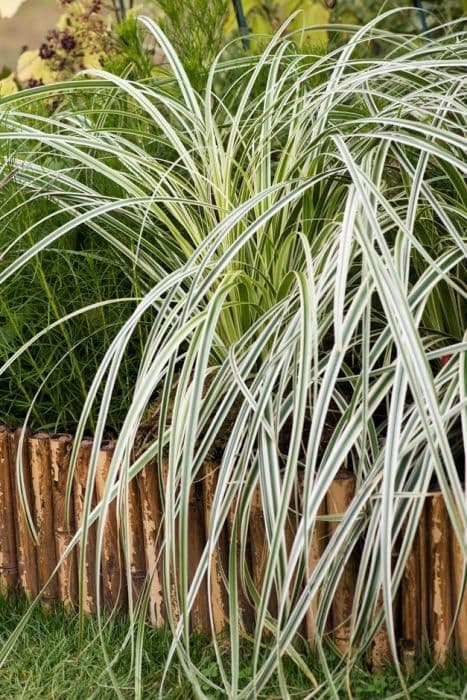Slender Tufted-sedge Carex acuta

ABOUT
The plant with the common name "Slender Tufted-Sedge" is characterized by its slender appearance and grass-like features, although it is not a true grass. Its leaves are narrow and strap-like, typically bright to dark green, and may show a slight V-shape when viewed in cross-section. The edges of the leaves can sometimes be rough to the touch. This plant grows in dense clumps or tufts, which contribute to its overall bushy appearance. Slender Tufted-Sedge produces flowering stems that bear small, green to brownish flower spikes. These spikes are often clustered at the top of the stems, with male flowers usually located above the female flowers. The female parts can develop into small, brownish, rounded fruits, often enclosed in tiny sac-like structures known as utricles, which can be a key identifying feature. Its overall growth pattern sees it forming thickets or mats in the wild, and it often has a preference for wetland areas such as the edges of streams and other bodies of water.
About this plant
 Names
NamesFamily
Cyperaceae
Synonyms
Slender Tufted-sedge, Sharp-pointed Sedge, Lesser Pond Sedge
Common names
Carex acuta var. substricta, Carex polyrrhiza, Carex stricta var. angustata, Carex stricta var. decolorans, Carex stricta var. rigida, Carex strictiformis, Vignea acuta.
 Characteristics
CharacteristicsLife cycle
Perennials
Foliage type
Deciduous
Color of leaves
Green
Flower color
Brown
Height
2-3 feet (60-90 cm)
Spread
1-2 feet (30-60 cm)
Plant type
Herb
Hardiness zones
4
Native area
Europe
Benefits
 General Benefits
General Benefits- Wildlife Habitat: Provides nesting materials and shelter for birds and other wildlife.
- Erosion Control: Establishes strong root systems that help stabilize soil and prevent erosion.
- Water Filtration: Helps to filter and purify water by trapping sediments and nutrients.
- Ornamental Features: Offers visual appeal in gardens with its grass-like foliage and greenish-brown flower spikes.
- Aquatic Edge Stability: Important for maintaining the integrity of pond edges and stream banks.
- Low Maintenance: Requires minimal care once established, making it suitable for natural landscaping.
- Climate Resilience: Tolerates a range of temperatures and moisture levels, adapting to changing environmental conditions.
- Biodiversity Support: Hosts a variety of insects, which in turn support birds and other wildlife.
- Cultural Significance: Used in traditional crafts and as a resource in indigenous cultures.
- Feed for Livestock: In some regions, it can be used as forage for livestock, particularly in wet areas.
- Habitat Restoration: Plays a role in restoration projects to recreate natural ecosystems.
- Carbon Sequestration: Contributes to carbon storage in soil, helping to mitigate climate change.
 Medical Properties
Medical Properties- This plant is not used for medical purposes.
 Air-purifying Qualities
Air-purifying QualitiesThis plant is not specifically known for air purifying qualities.
 Other Uses
Other Uses- Carex acuta, commonly known as slender tufted-sedge, can be used in constructed wetlands for wastewater treatment, taking advantage of its high tolerance to water pollution and its dense root system that helps filter contaminants.
- In some regions, the sturdy stems of slender tufted-sedge are woven into baskets or mats, capitalizing on their natural flexibility and strength when harvested.
- The fibrous roots of slender tufted-sedge can be used to stabilize stream banks and prevent soil erosion, as they help bind the soil effectively.
- Slender tufted-sedge can be planted as an ornamental grass in water gardens and pond edges, offering a natural aesthetic and enhancing biodiversity.
- The seeds of slender tufted-sedge provide food for various species of waterfowl and birds, contributing to the local ecosystem as a natural food source.
- Due to its dense growth, slender tufted-sedge can be used as ground cover in large landscaping projects to suppress weeds and reduce maintenance.
- Farmers sometimes use slender tufted-sedge as bedding material for livestock because it is absorbent and readily available in wetland areas.
- The plant is used for crafting decorative items, such as wreaths and floral arrangements, especially in regions where it grows abundantly.
- Slender tufted-sedge can be used as a natural dye source; the plant parts, when processed, yield a variety of earthy tones.
- As part of habitat restoration projects, slender tufted-sedge is planted to recreate the natural wetland environments necessary for many amphibians and insects.
Interesting Facts
 Feng Shui
Feng ShuiThe plant Carex acuta, commonly known as the sharp sedge, is not used in Feng Shui practice.
 Zodiac Sign Compitability
Zodiac Sign CompitabilityThe sharp sedge is not used in astrology practice.
 Plant Symbolism
Plant Symbolism- Adaptability: Carex acuta, commonly known as "Slender-tufted sedge," often grows in various wetland habitats, symbolizing its adaptability to different environmental conditions.
- Resilience: This plant's ability to thrive in waterlogged soils where other plants might struggle indicates resilience in the face of adversity.
- Sustainability: As a sedge, Carex acuta plays an important role in its ecosystem, representing sustainability and the importance of each species in maintaining ecological balance.
 Water
WaterThe slender tufted sedge, commonly known as Carex acuta, thrives in consistently moist soil conditions and should be watered thoroughly when the top inch of the soil feels dry to the touch, which may be once or twice a week depending on the climate and soil drainage. In general, aim to provide the plant with about 1 to 1.5 gallons of water every week, ensuring even distribution around the base of the plant to avoid waterlogging. During the summer or in hotter climates, watering frequency should be increased to maintain soil moisture, while in cooler months or rainy conditions, reduce the frequency accordingly. Always check the soil moisture level before watering to prevent overwatering.
 Light
LightCarex acuta, or slender tufted sedge, prefers full to partial sunlight, thriving best when it receives at least four to six hours of direct sunlight daily. It can tolerate some shade, especially in the hotter part of the day, so placing it in a spot where it gets morning sun and afternoon shade would be ideal. Avoid deep shade as it may lead to sparse growth and reduced vigor of the plant.
 Temperature
TemperatureSlender tufted sedge, or Carex acuta, grows well in a wide range of temperatures, typically between 50°F and 85°F, which are conditions commonly found in temperate regions. The plant can survive temperatures down to around 20°F but it's important to protect it from prolonged freezing to prevent damage. The ideal growing temperatures for maximum growth and health are often between 60°F and 75°F.
 Pruning
PruningPruning the slender tufted sedge, or Carex acuta, is generally done to remove dead or yellowing foliage and to maintain the plant's tidy appearance. It should be pruned lightly in early spring or late winter before new growth begins. Cut back the foliage by about one-third to encourage fresh, new growth. Annually or biannually pruning is usually sufficient for Carex acuta.
 Cleaning
CleaningAs needed
 Soil
SoilSharp-pointed sedge, commonly known as Carex acuta, prefers moist to wet soil with good drainage and thrives best in soil with a pH ranging from 5.5 to 7.5. A mix of loamy soil with organic matter such as compost or peat, and some sand to improve drainage would be ideal for growing this plant.
 Repotting
RepottingSharp-pointed sedge typically does not require frequent repotting; it can be done every 2 to 3 years to refresh the soil and divide the clumps if necessary. Ensure that the new pot provides ample space for growth and drainage.
 Humidity & Misting
Humidity & MistingSharp-pointed sedge is adapted to outdoor conditions and does well in average to high humidity levels, typically preferring an environment similar to its natural wetland habitat.
 Suitable locations
Suitable locationsIndoor
Place in bright light, keep soil moist, and ensure good air circulation.
Outdoor
Plant in wet areas with partial to full sun exposure.
Hardiness zone
4-9 USDA
 Life cycle
Life cycleThe life of Carex acuta, commonly known as slender tufted-sedge, begins with seed germination, which requires a moist environment and occurs in spring. Upon germination, the seed develops into a seedling with thin, grass-like leaves. As the plant matures, it forms a clump of dense foliage with stiff, triangular stems, and reaches reproductive stage in late spring to summer. During this time, slender tufted-sedge produces unisexual flowers, with separate male and female spikelets, primarily relying on wind for pollination. After pollination, seeds develop and are dispersed, often by water, facilitating the colonization of new areas. The plant's perennial nature ensures its survival over the years through underground rhizomes, which give rise to new shoots annually.
 Propogation
PropogationPropogation time
Spring to Summer
The slender-tufted sedge, scientifically known as Carex acuta, is commonly propagated through division, one of its most popular methods. The ideal time to propagate is during the late winter to early spring months, just before the start of the growing season when the plant is not actively growing. To propagate through division, carefully dig up an established clump of slender-tufted sedge, taking care not to damage the roots. With a sharp knife or spade, divide the clump into smaller sections, each containing a portion of the roots and several shoots. Replant the divisions immediately at the same depth they were originally growing, spacing them about 12 inches (roughly 30 centimeters) apart to accommodate future growth. Water the new plantings well to help establish the roots. This simple method allows for quick increase of plant stock and helps rejuvenate older clumps that may have become too dense.


![Japanese sedge [Everest]](/_next/image?url=https%3A%2F%2Fplants-admin.emdemapps.com%2Fimages%2Fplants%2F%2Fimages%2F604b5b6de0548.png&w=640&q=75)






